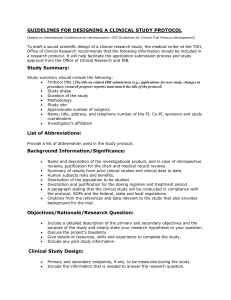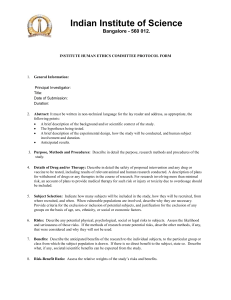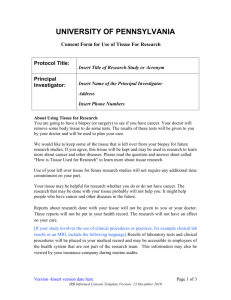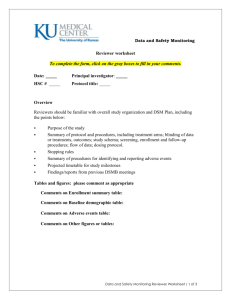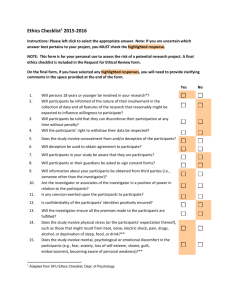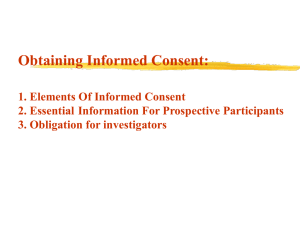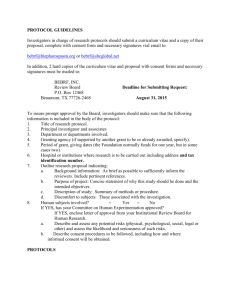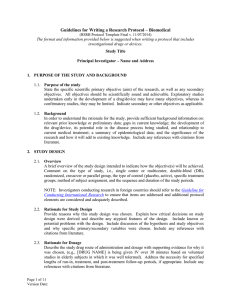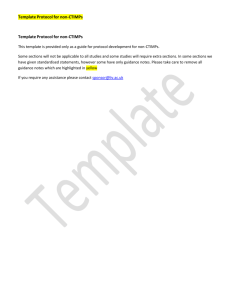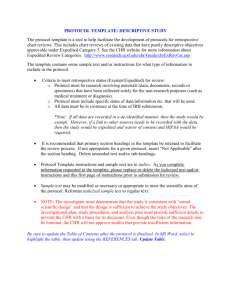Research Study Protocol Template
advertisement
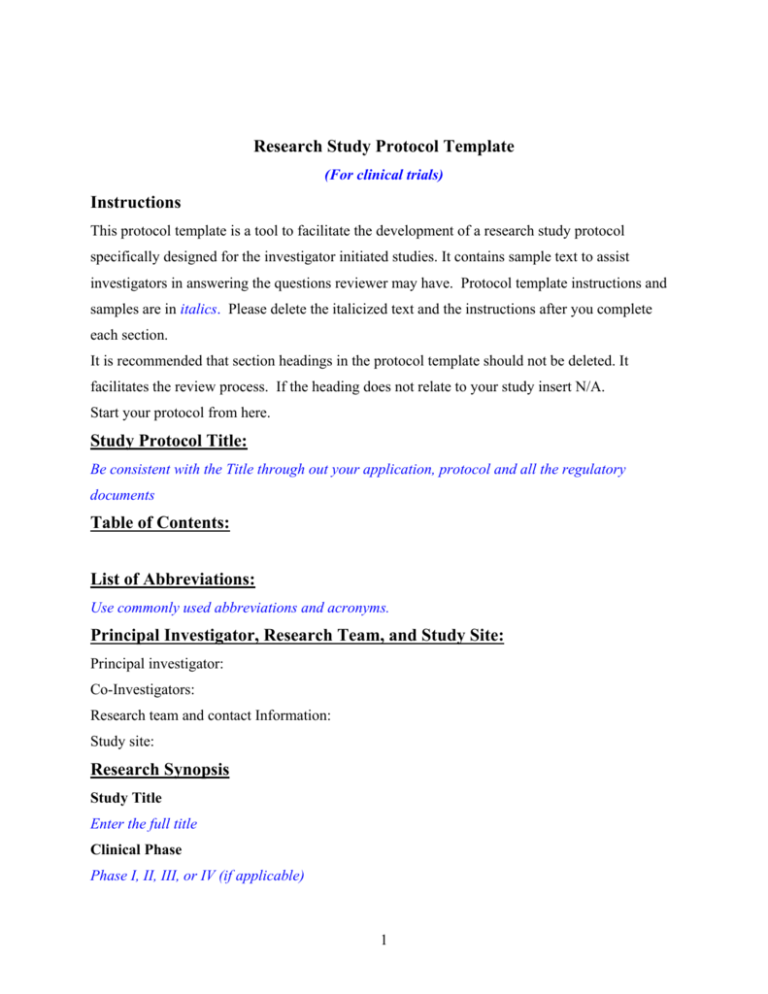
Research Study Protocol Template (For clinical trials) Instructions This protocol template is a tool to facilitate the development of a research study protocol specifically designed for the investigator initiated studies. It contains sample text to assist investigators in answering the questions reviewer may have. Protocol template instructions and samples are in italics. Please delete the italicized text and the instructions after you complete each section. It is recommended that section headings in the protocol template should not be deleted. It facilitates the review process. If the heading does not relate to your study insert N/A. Start your protocol from here. Study Protocol Title: Be consistent with the Title through out your application, protocol and all the regulatory documents Table of Contents: List of Abbreviations: Use commonly used abbreviations and acronyms. Principal Investigator, Research Team, and Study Site: Principal investigator: Co-Investigators: Research team and contact Information: Study site: Research Synopsis Study Title Enter the full title Clinical Phase Phase I, II, III, or IV (if applicable) 1 IND Sponsor Name of IND Sponsor (if applicable) Study Population Include a brief description of the population such as health/disease status, gender, age, etc. Study Design Present an overview of the study design for example, randomized controlled trial, or double blinded, crossover or parallel study etc Sample Size Include total number of patients for the study including other sites. Include sample size plus an estimate for screen failures. Study Duration Length of time to enroll human subjects in the study till the completion of the study Study Agent and Intervention Description (If applicable) Include name, dose, frequency, and route of administration, if applicable Primary Objective Include primary objective and outcome measures Secondary Objectives Include secondary objectives, outcome measures Background and Significance: This section is based on your research question. How would you answer the questions and give explanations to your answer? What are the assumptions and relationships? Justification of your conducting this study based on existing knowledge and your research question. Describe the disease including incidence Description of the Study drug/intervention Provide summary of previous pre-clinical studies, relevant clinical studies Include references with citations from the literature. In the last paragraph state the main purpose of the study summarizing all the information provided in your background section 2 Objectives: These should be written after the theoretical framework has been developed. The objectives are the intellectual activities that the investigator will perform throughout the research process. Primary Objective Include the details of your primary objective (which is your main purpose of performing this study and should be focused on one question), outcome measures and method by which outcomes will be determined. Sample Text: To evaluate the efficacy of antibiotics in the treatment of acute bronchitis Secondary Objectives Include secondary objectives which can be two or three can be dependent or independent of the primary objective, outcome measures and method by which secondary outcomes will be determined. Sample text: To assess patients overall change in symptoms and return to daily activities after 2 weeks of antibiotic treatment To evaluate management and treatment factors as potential predictors of outcome. Study design/methodology: Include the description of study type (double-blinded, placebo-controlled, open/off label, parallel or crossover design, randomized), number of study arms, prospective, retrospective, or observational, survey, or questionnaire Type of study and design should be decided on the basis of proposed objectives and the availability of the resources. The methodology explains the procedures that will be used to achieve the objectives. In this section detail of the variables and the ways to measure them should be included. Example text: This is a randomized, double blind study of ….. for the treatment of ….in this patient population How are you planning to do this study? Details of the methods and procedures should be included 3 What kind of data will you be collecting to measure your primary and secondary outcomes? What type of randomization method will be used? Study Population: Details of the population to be included in the study Inclusion /Exclusion Criteria Sample text inclusion criteria: Confirmed cases of the disease……. Treated at ------Hospital between ---year and----- year Women of childbearing potential may not be routinely excluded from participating in research, however, pregnant women should be excluded unless there is a clear justification to include them. Include enrollment of subjects with diverse racial and ethnic backgrounds to ensure an equitable selection. Study drug /Interventions: Formulation, packaging, and labeling of the study drug Address issues with the study drug storage and stability Provide details of the preparation, administration, and dosage of study drug/intervention) Study Schedule: Include a projected start date. Provide the total length of time participants will remain in the study or will be taking drug including the follow up period. Include an approximate end date of the study. It is convenient for the reviewer to see the events of the study schedule or duration in the form of a flow chart. Include screening, enrollment, active dosing phase, follow-up visits, and final study visit. Adverse Event Reporting: Provide a definition of an Adverse Event (AEs) and Serious Adverse Event (SAEs) based on the study. Include methods and timings for assessing, recording, and managing adverse events and safety parameters 4 Also include how will you report these procedures and stopping rules for a study participant? Statistical Analysis Plan: What do you plan to analyze from the data you collect? Consult a biostatistician before you finalize your protocol. Sample size determination What sample size will you be able to get and if your suggested samples size has enough of power to deliver the significant results? Include the number of subjects you are planning to enroll. For multi-center studies, include the total number of sites expected and the total number of subjects to be enrolled across all sites. Provide the rationale for the sample size, the calculations on the power of the trial and the clinical justification. Include plan of accounting for missing, unused and spurious data Informed Consent Process: Provide information about the regulatory requirements of the consent form and which languages will be used. For Spanish speaking population a Spanish consent form should be included. The language and writing of an informed consent is usually at a 6th grade level. Include a justification if potentially vulnerable subjects will be enrolled in the study for example pregnant and lactating women, children, prisoners, cognitively impaired and critically ill subjects. Privacy and confidentiality: Sample language: Human subject’s names will be kept on a password protected database, and will be linked only with a study identification number for this research. There are no patient identifiers. All data will be entered into a computer that is password protected. Data will be stored in a locked office of the investigators and usually maintained for a minimum of three years after the completion of the study. Some institutions have different time frame for the storage of data. Check institutional SOPs Risk/Benefit: Risk to participants: Identify any risks involved while conducting the study 5 Benefits to Participants Include any benefits to the participant or to the overall research field Sample text: This study does not present the prospect of direct benefit to the participants. However the study does provide an opportunity to gain a better understanding of… Study Timeline: Briefly state the stages of your study for example, Stage 1, screening, enrollment, ----4-6 months Stage 2, treatment phase Stage 3, data collection and data analysis Stage 4, presentation and publication… Data Safety Monitoring: Monitoring is an ongoing review of the study throughout its duration. Any action resulting in a temporary or permanent suspension or delay of the study should be reported to the IRB and to the Office of Clinical Research The PI is responsible for reporting any reasons outside the planned study design such as incompliance with the protocol or if there is any delay in the initiation of the study due to administrative reasons. . Plans for collecting data and protocol compliance should be included Conflict of Interest: Clearly document any consultative relationship that the principal or co-investigators has with a non-USF entity related to the protocol that might be considered a conflict of interest. Depending upon the type of conflicts, these can be managed accordingly. Consult USF COI committee. Publication and Presentation Plans: List any meetings or conferences where you will be presenting the data and the results of your study. References: List all the references used in the back ground section at the end of the protocol. Endnote and reference Manager are the software tools for publishing and managing bibliographies and are used frequently for citations and managing your own libraries. 6
